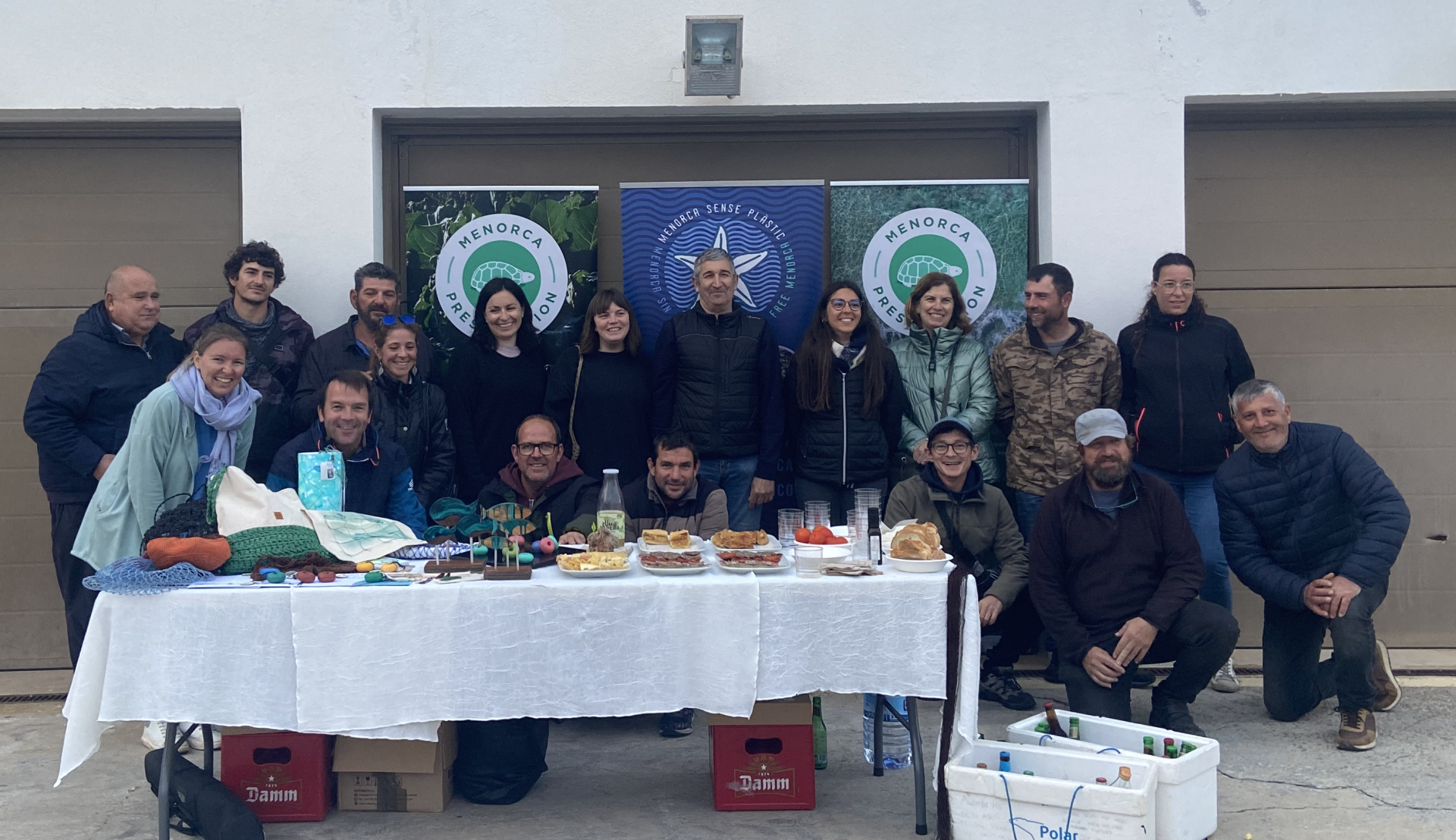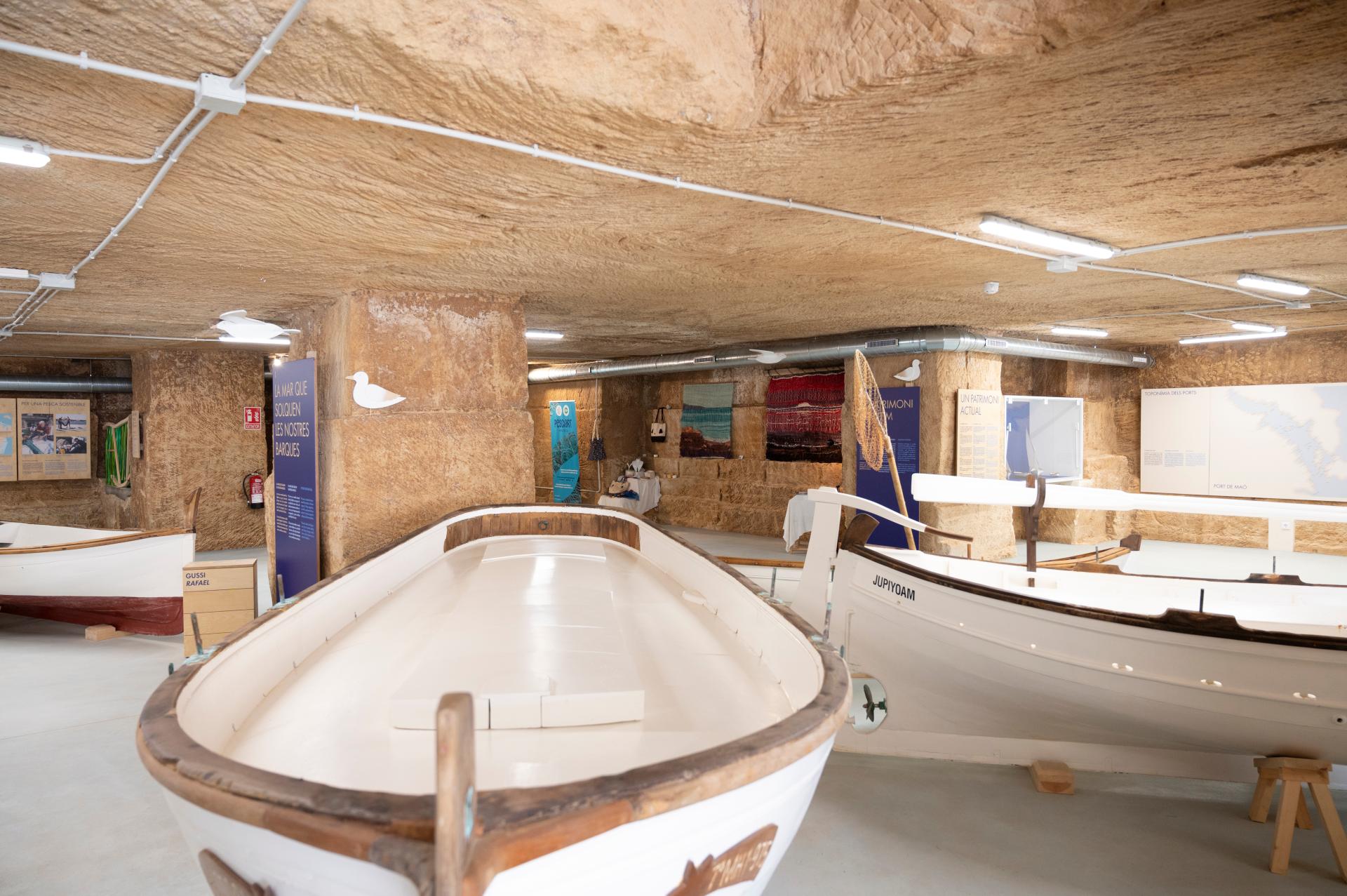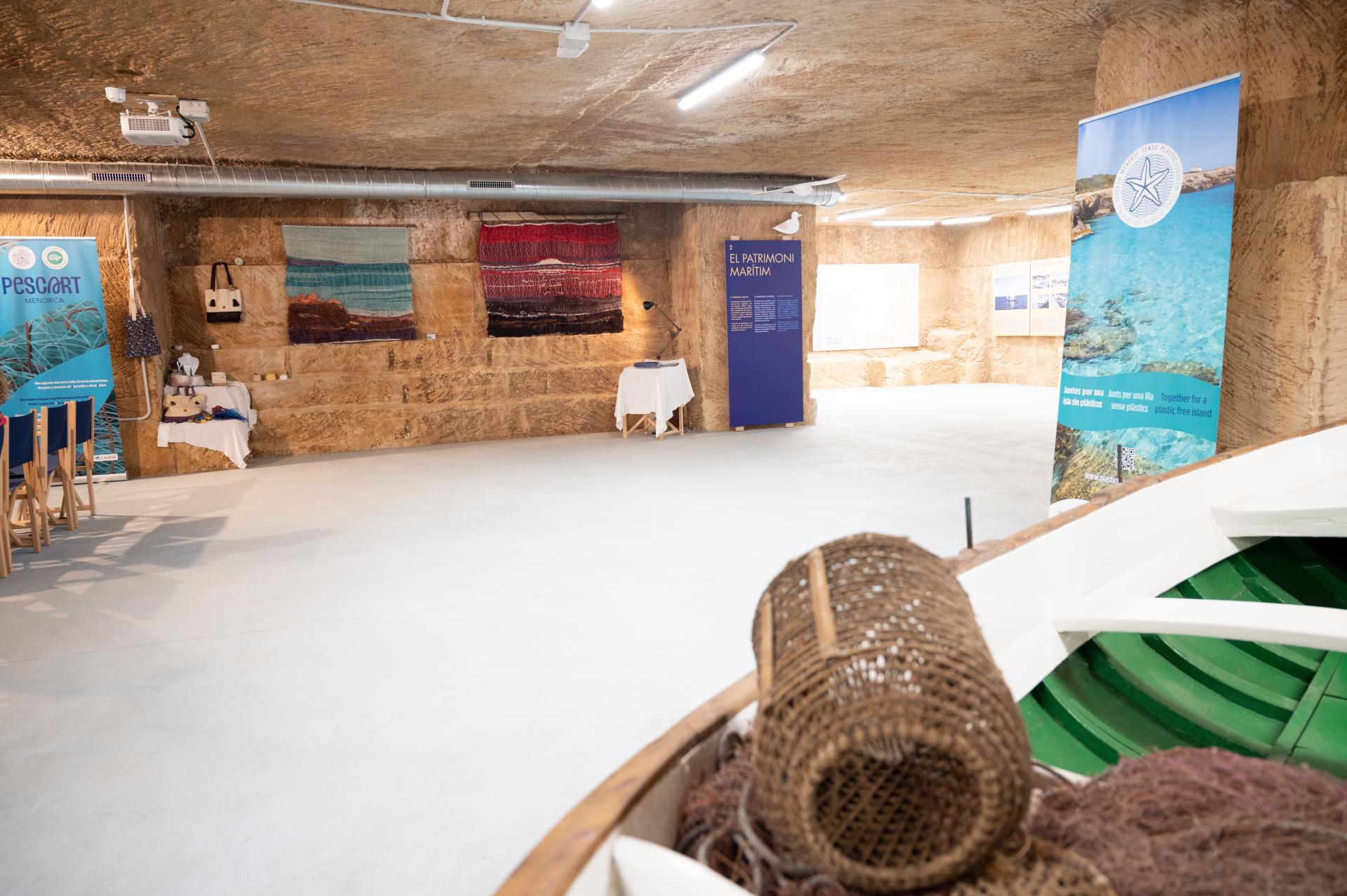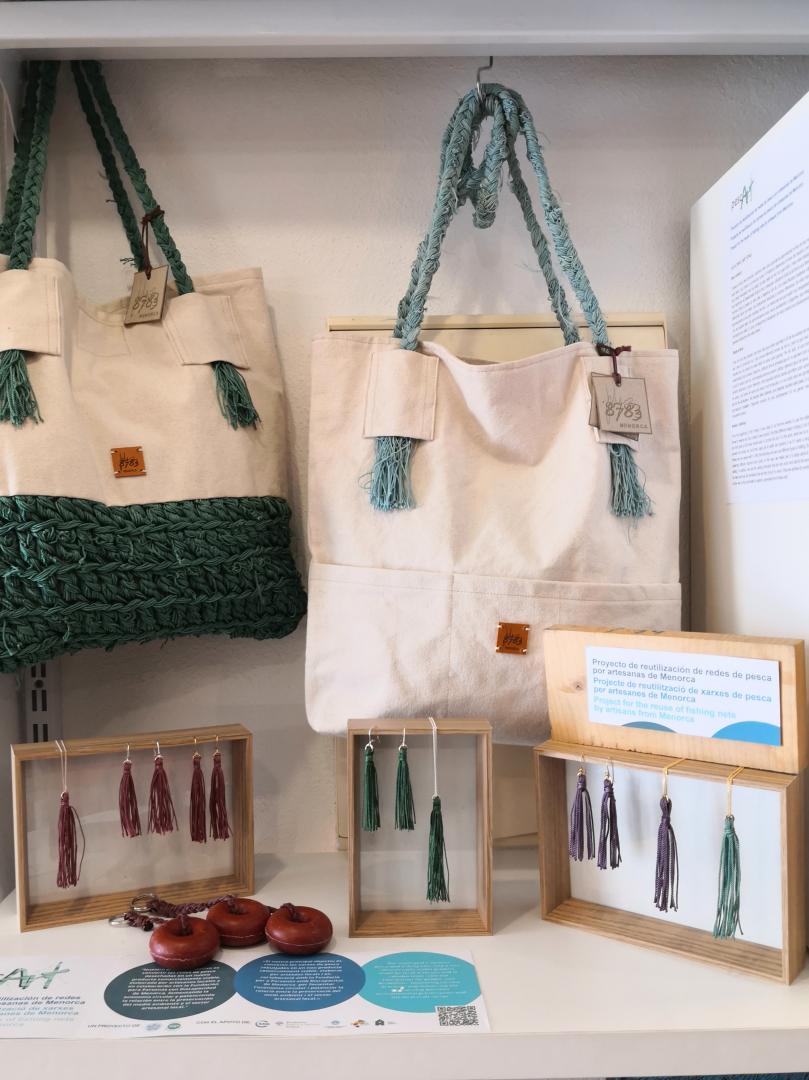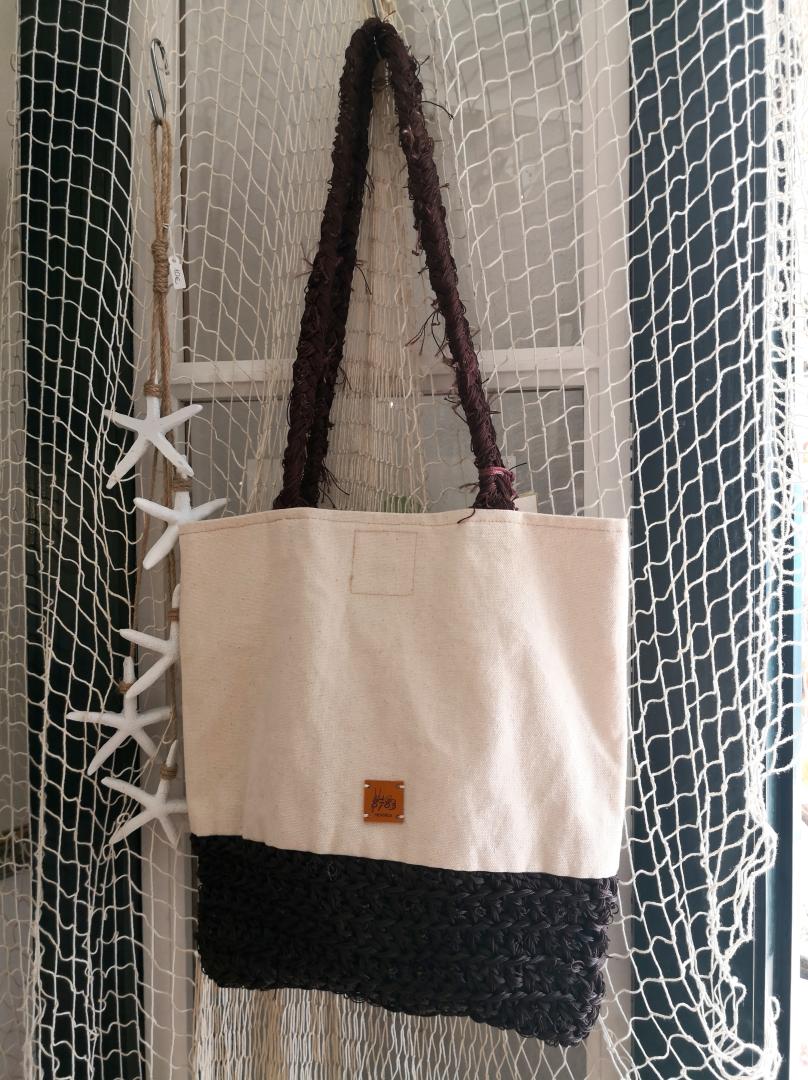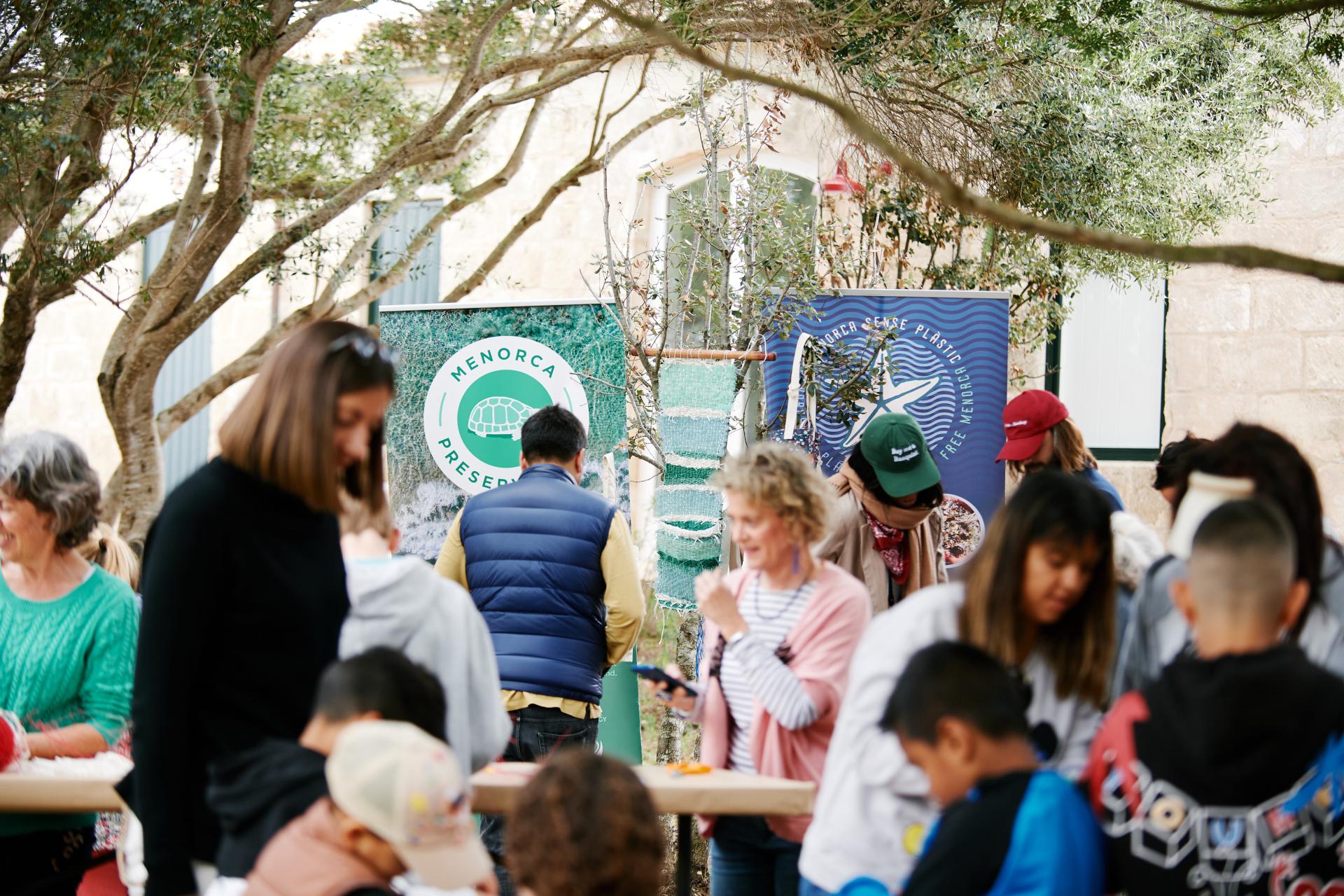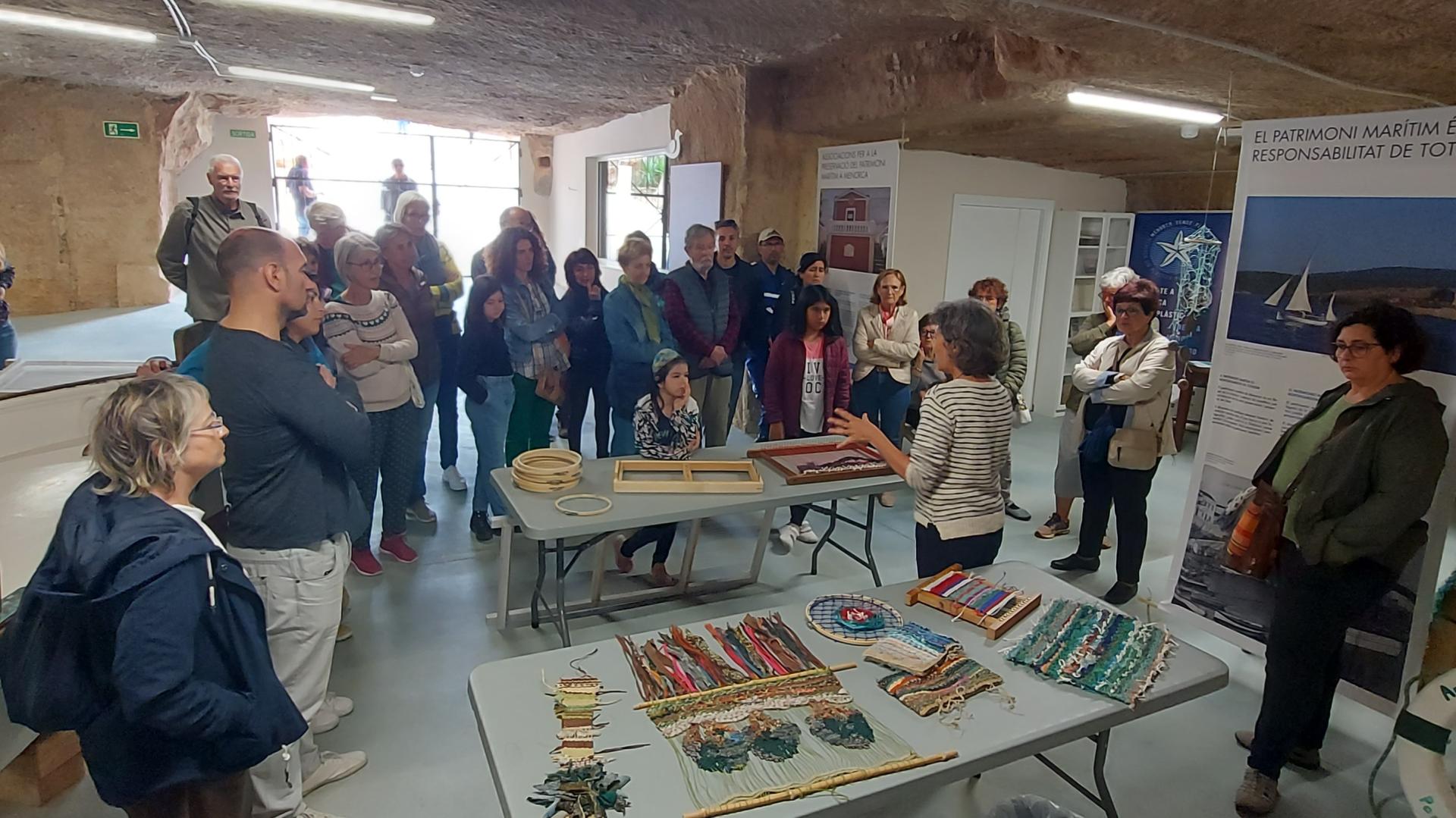PescArt Menorca. Upcycling fishing nets
Basic information
Project Title
PescArt Menorca. Upcycling fishing nets
Full project title
PescArt Menorca. Upcycling discarded fishing nets by artisans and artists from Menorca
Category
Shaping a circular industrial ecosystem and supporting life-cycle thinking
Project Description
PescArt Menorca is a circular economy project whose objective is to promote the conversion of discarded fishing nets into new commercially viable products. The initiative seeks to reduce the significant environmental of this waste. The initiative aims to restore value to waste, promoting the symbiosis between the environment preservation and the local productive sector, through cooperating with the fishing sector and key social actors.
Geographical Scope
Local
Project Region
Island of Menorca (8 municipalities), Spain
Urban or rural issues
It addresses urban-rural linkages
Physical or other transformations
It refers to other types of transformations (soft investment)
EU Programme or fund
No
Description of the project
Summary
The process starts with the vital collaboration of the island's fishermen's associations, whose fishermen deposit the broken or damaged nets in the containers. We then manage its logistics of collection and storage. From here, the revitalisation through the artistic and craft union comes into action. A part of the fishing nets are referred to the Menorca Foundation for People with Disabilities for their segregation and organisation. The Foundation is, in fact, a fundamental part of the process, since they facilitate and speed up the productive process for the artisans and artists. The revitalisations and awareness actions reach the public through different training organisations, especially primary schools, institutes and professional training centers, as well as Cáritas and the Red Cross, with whom we develop informative workshops and training courses for employment. Innovation is also part of the project: we explore different outlets for the networks together with the BIT Foundation, such as its use as a filament for 3D printers.
Key objectives for sustainability
The connection between the mentioned project and the New European Bauhaus umbrella lies in their shared goals and objectives related to sustainability, environmental awareness, circularity, and social inclusion. On the one hand, the project involves the conversion of discarded fishing nets into new products, which significantly contributes to reducing plastic pollution in marine and terrestrial environments. This aligns with the sustainability dimension of the New European Bauhaus, which emphasizes circularity, environmental preservation, and reducing the negative impact of waste on ecosystems. Secondly, the project promotes the circular economy by reusing discarded materials (fishing nets) to create new products with commercial viability. This reduces the need for new natural resources and energy, aligning with the concept of circularity advocated by the New European Bauhaus.
Thirdly, the project actively engages citizens in workshops and sessions, raising awareness about environmental issues and demonstrating how innovation and collaboration can effectively address these problems. This aligns with the New European Bauhaus's goal of transforming our forms of living to be more sustainable and beautiful. Lastly, the project collaborates with local artisans, fishermen's guilds, and organizations supporting people with disabilities and those in situations of social exclusion. This collaboration strengthens the local community, provides employment opportunities, and empowers individuals, promoting social inclusion. These actions align with the New European Bauhaus's goal of promoting inclusion, accessibility, and affordability in societal transformations.
In summary, the project's objectives and actions closely align with the core values of the New European Bauhaus, which seeks to facilitate a collaborative and multidisciplinary societal transformation towards more beautiful, sustainable, and inclusive living environments.
Thirdly, the project actively engages citizens in workshops and sessions, raising awareness about environmental issues and demonstrating how innovation and collaboration can effectively address these problems. This aligns with the New European Bauhaus's goal of transforming our forms of living to be more sustainable and beautiful. Lastly, the project collaborates with local artisans, fishermen's guilds, and organizations supporting people with disabilities and those in situations of social exclusion. This collaboration strengthens the local community, provides employment opportunities, and empowers individuals, promoting social inclusion. These actions align with the New European Bauhaus's goal of promoting inclusion, accessibility, and affordability in societal transformations.
In summary, the project's objectives and actions closely align with the core values of the New European Bauhaus, which seeks to facilitate a collaborative and multidisciplinary societal transformation towards more beautiful, sustainable, and inclusive living environments.
Key objectives for aesthetics and quality
On the one hand, the project aims to enhance aesthetics and design by converting discarded fishing nets into new products. This involves a creative approach to repurposing materials, which contribute to the visual appeal of the products and the surrounding environment. The project has also successfully upcycled discarded fishing nets into new products, which have a unique and aesthetically pleasing design. By collaborating with local artisans and artists, the project combines environmental preservation with local artistry. This not only creates products with a distinct and visually appealing aesthetic but also showcases the beauty of sustainable and circular design.
On the other hand, the project aims to improve the quality of experience for people by providing workshops and sessions open to citizens. These activities are designed to raise environmental awareness and demonstrate how environmental problems can be effectively addressed through innovation and collaboration. The project has also successfully engaged citizens through workshops and sessions, which have had a positive impact on the quality of their experiences. By actively involving the community in addressing environmental issues, the project not only raises awareness but also empowers individuals to be part of a solution. This direct engagement enhances the quality of experience for participants by providing them with a sense of purpose and contributing to their understanding of sustainability.
Lastly, the project seeks to strengthen the community and local economy by collaborating with local artisans and fishermen's guilds. It also collaborates with occupational centers of the Foundation for People with Disabilities, Cáritas, and the Red Cross to provide employment opportunities and empowerment to individuals facing difficulties. It has achieved its objective of strengthening the community and local economy via collaboration.
On the other hand, the project aims to improve the quality of experience for people by providing workshops and sessions open to citizens. These activities are designed to raise environmental awareness and demonstrate how environmental problems can be effectively addressed through innovation and collaboration. The project has also successfully engaged citizens through workshops and sessions, which have had a positive impact on the quality of their experiences. By actively involving the community in addressing environmental issues, the project not only raises awareness but also empowers individuals to be part of a solution. This direct engagement enhances the quality of experience for participants by providing them with a sense of purpose and contributing to their understanding of sustainability.
Lastly, the project seeks to strengthen the community and local economy by collaborating with local artisans and fishermen's guilds. It also collaborates with occupational centers of the Foundation for People with Disabilities, Cáritas, and the Red Cross to provide employment opportunities and empowerment to individuals facing difficulties. It has achieved its objective of strengthening the community and local economy via collaboration.
Key objectives for inclusion
The connection between the project and the New European Bauhaus umbrella in terms of inclusion, including accessibility and affordability, can be seen in several ways:
Primarely the project actively collaborates with local artisans, fishermen's guilds, and organizations supporting people with disabilities and individuals in situations of social exclusion. This collaboration not only strengthens the local community but also provides employment opportunities and empowerment for people facing difficulties. This aligns with the inclusivity dimension of the New European Bauhaus, as it fosters social inclusion by creating economic opportunities and improving the quality of life for marginalized individuals.
Secondly, by engaging in collaboration with groups like the Foundation for People with Disabilities, Cáritas, and the Red Cross, the project ensures that it is accessible and affordable for a wider range of individuals, including those with disabilities and those in challenging social situations. This aligns with the New European Bauhaus's goal of promoting projects that are not only beautiful and sustainable but also accessible and affordable for all members of society.
Thirdly, the initiative includes collaboration with various local organizations and stakeholders suggests a participatory approach to decision-making and governance. Inclusivity in the decision-making process is an important aspect of the New European Bauhaus, aiming to involve a diverse range of voices in shaping the transformation of living environments.
Lastly, the project's approach of collaborating with local artisans and using discarded materials in a circular economy model aligns with the concept of "design for all". It demonstrates a commitment to creating products and environments that are not only sustainable but also accessible and functional for a broad audience.
Primarely the project actively collaborates with local artisans, fishermen's guilds, and organizations supporting people with disabilities and individuals in situations of social exclusion. This collaboration not only strengthens the local community but also provides employment opportunities and empowerment for people facing difficulties. This aligns with the inclusivity dimension of the New European Bauhaus, as it fosters social inclusion by creating economic opportunities and improving the quality of life for marginalized individuals.
Secondly, by engaging in collaboration with groups like the Foundation for People with Disabilities, Cáritas, and the Red Cross, the project ensures that it is accessible and affordable for a wider range of individuals, including those with disabilities and those in challenging social situations. This aligns with the New European Bauhaus's goal of promoting projects that are not only beautiful and sustainable but also accessible and affordable for all members of society.
Thirdly, the initiative includes collaboration with various local organizations and stakeholders suggests a participatory approach to decision-making and governance. Inclusivity in the decision-making process is an important aspect of the New European Bauhaus, aiming to involve a diverse range of voices in shaping the transformation of living environments.
Lastly, the project's approach of collaborating with local artisans and using discarded materials in a circular economy model aligns with the concept of "design for all". It demonstrates a commitment to creating products and environments that are not only sustainable but also accessible and functional for a broad audience.
Results in relation to category
During the execution of this project, work has been carried out in parallel on the different lines of action. On the one hand, the collaborative relationship with fishing guilds and port management bodies has been strengthened to obtain access to discarded fishing nets. On the other hand, local artisans and artists interested in working with fishing nets have been identified and contacted, offering ad hoc training and supporting the development of their own brand and visual identity. At the same time, new sales channels have been opened through local stores and tourist establishments, and a website has been created to expose the project, its products and work, and the creators involved. Likewise, the third sector has been intensely involved, establishing a direct line of collaboration with two special employment centers for people with disabilities, with people at risk or in a situation of social exclusion. It should also be noted that collaborations have been sought with public administration both at the local and island level, environmental organizations, educational institutions and local companies. Finally, it is worth noting that two exhibitions and several workshops have been held for specific groups and for citizens in general in order to raise awareness about environmental problems related to fishing nets and other plastics, and the importance of reuse.
How Citizens benefit
As for direct beneficiaries, the project directly involves fishermen (78) and local artisans and artists (25) in the process. They benefit from the collaboration by having a role in converting discarded fishing nets into new products. This collaboration not only provides employment and income opportunities but also strengthens the local economy. This engagement is in harmony with the sustainability dimension of the New European Bauhaus, as it promotes local economic development and resource reuse.
By training and involving users of social entities, the project empowers individuals (167 people) who are facing social exclusion or difficulties. This direct involvement has a positive impact on their quality of life, providing employment opportunities and a sense of purpose. It aligns with the inclusivity dimension of the New European Bauhaus, which seeks to improve the quality of experience and inclusion for all.
As for indirect beneficiaries, the project indirectly benefits a wider group of individuals, through its positive impact on the environment, economy, and community. This includes local residents, tourists, and others who indirectly benefit from reduced plastic pollution and the promotion of a circular economy (90.000 local residents plus 1 million tourists per year). This indirect impact contributes to making living environments more sustainable, in harmony with nature, and aesthetically pleasing, as envisioned by the New European Bauhaus. An indirect further impact extends to a larger scale, which includes those who are inspired by the project's success and may consider replicating similar initiatives in their own communities. The project's model serves as an example of how environmental sustainability, circularity, and social inclusion can be integrated into a holistic approach to community development.
By training and involving users of social entities, the project empowers individuals (167 people) who are facing social exclusion or difficulties. This direct involvement has a positive impact on their quality of life, providing employment opportunities and a sense of purpose. It aligns with the inclusivity dimension of the New European Bauhaus, which seeks to improve the quality of experience and inclusion for all.
As for indirect beneficiaries, the project indirectly benefits a wider group of individuals, through its positive impact on the environment, economy, and community. This includes local residents, tourists, and others who indirectly benefit from reduced plastic pollution and the promotion of a circular economy (90.000 local residents plus 1 million tourists per year). This indirect impact contributes to making living environments more sustainable, in harmony with nature, and aesthetically pleasing, as envisioned by the New European Bauhaus. An indirect further impact extends to a larger scale, which includes those who are inspired by the project's success and may consider replicating similar initiatives in their own communities. The project's model serves as an example of how environmental sustainability, circularity, and social inclusion can be integrated into a holistic approach to community development.
Physical or other transformations
It refers to other types of transformations (soft investment)
Innovative character
Firstly, the innovation factors incorporated go through the focus on the circular economy, recognizing its importance as a practical necessity to address environmental problems and minimize resource waste. This approach promotes the reduction, upcycling and recycling of materials, which is essential for long-term sustainability. On the other hand, simplicity and manual work are incorporated into the project, understanding that innovation lies in returning to simplicity and using manual work methods instead of energy-intensive industrial processes. This not only reduces your energy, water and greenhouse gas emissions bill, but also promotes a greater connection to local crafts and creativity. Likewise, by using nets as raw material for artisanal products, a creative way of addressing the problem of plastic waste has been achieved, involving a revaluation of a material that would otherwise be discarded and contributing to the reduction of environmental pollution. In turn, collaborating with local artisans not only adds a component of cultural authenticity to the products, but also supports the local economy and encourages the development of traditional artisan skills. Finally, the inclusion of people with disabilities and those in situations of social exclusion adds a very valuable social component to the project, not only promoting diversity and inclusion, but also offering significant employment opportunities to people who often face employment barriers.
Disciplines/knowledge reflected
Primarily, the project incorporates artistic works and craft products created from discarded fishing nets. Artists and designers play a crucial role in upcycling these materials into aesthetically pleasing and unique products. This discipline contributes to the aesthetics and design aspects of the project, as these individuals are responsible for creating products such as bags, key rings, pendants, and earrings, contributing to the cultural and artistic elements of the project.
Secondly, to address the environmental sustainability objectives, knowledge from environmental science is essential. This includes understanding the impact of discarded fishing nets on ecosystems and the marine and land environment, as well as the principles of circular economy.
The project's focus on reusing discarded materials and promoting a circular economy also reflects expertise in sustainability and circular economy principles.
Furthermore, the involvement of individuals with disabilities and groups in situations of social exclusion needs knowledge in this.
Lastly, to ensure the commercial viability of the products created, knowledge in business and entrepreneurship is required. This includes aspects such as market research, pricing, marketing, and sales strategies, while building partnerships with various stakeholders, including artisanal businesses, local entities, and social organizations, requires skills in collaboration and networking. Effective collaboration is essential for the success of the project.
Secondly, to address the environmental sustainability objectives, knowledge from environmental science is essential. This includes understanding the impact of discarded fishing nets on ecosystems and the marine and land environment, as well as the principles of circular economy.
The project's focus on reusing discarded materials and promoting a circular economy also reflects expertise in sustainability and circular economy principles.
Furthermore, the involvement of individuals with disabilities and groups in situations of social exclusion needs knowledge in this.
Lastly, to ensure the commercial viability of the products created, knowledge in business and entrepreneurship is required. This includes aspects such as market research, pricing, marketing, and sales strategies, while building partnerships with various stakeholders, including artisanal businesses, local entities, and social organizations, requires skills in collaboration and networking. Effective collaboration is essential for the success of the project.
Methodology used
To evaluate the impact and results, an impact measurement system was defined, establishing specific indicators and metrics that reflect the progress and results in each of these aspects and their progress in each quarter of project execution. The method was developed based on the following objective items: avoid plastic pollution in the marine and terrestrial environment and provide a solution to waste, involve and raise awareness in the fishing sector, involve and support artisans and artists, support marketing of the products and parts, involve the third sector, raise awareness and sensitize, support entrepreneurship and disseminate the project and its support.
How stakeholders are engaged
As for local engagement, the Menorca Foundation for People with Disabilities, through its S’Auba and Carlos Mir Occupational Centers in Ciutadella and Mahón, has played a key role in the project. Their involvement includes segregating and separating discarded fishing nets for recycling. This direct collaboration promotes social inclusion and employment opportunities for individuals with disabilities. Collaboration with social entities (Red Cross, Cadena de Favores Association, Cáritas) involves offering workshops and occupational training. This engagement goes beyond economic benefits and aligns with the social inclusion dimension, as it empowers individuals facing social challenges.
The project extends its reach by engaging with cultural and exhibition centers, schools, and residences for the elderly. Workshops and exhibitions have been conducted in various cultural centers, reaching a wider audience. This involvement fosters community engagement and aligns with the project's goals of creating aesthetically pleasing and inclusive experiences. The city councils (Ciutadella, Es Mercadal, Es Castell, Mahón) and the Insular Council of Menorca's collaborations indicates a high level of engagement. Their support likely includes permits, promotion, and potentially funding, contributing to the project's success and alignment with local and regional policies.
As for regional and national involvement, the support of Ports IB contributes to the project's viability and potential scalability, as well as do CentreBIT implication and The GravityWave collaboration agreement.
The project extends its reach by engaging with cultural and exhibition centers, schools, and residences for the elderly. Workshops and exhibitions have been conducted in various cultural centers, reaching a wider audience. This involvement fosters community engagement and aligns with the project's goals of creating aesthetically pleasing and inclusive experiences. The city councils (Ciutadella, Es Mercadal, Es Castell, Mahón) and the Insular Council of Menorca's collaborations indicates a high level of engagement. Their support likely includes permits, promotion, and potentially funding, contributing to the project's success and alignment with local and regional policies.
As for regional and national involvement, the support of Ports IB contributes to the project's viability and potential scalability, as well as do CentreBIT implication and The GravityWave collaboration agreement.
Global challenges
PescArt Menorca project aligns with several of the United Nations Sustainable Development Goals (SDGs) due to its focus on environmental sustainability, circular economy, social integration, and collaboration (SDG 13).
The project's core objective is to promote a circular economy by converting discarded fishing nets into new commercially viable products. This aligns with SDG 12's goal of ensuring sustainable consumption and production patterns by reducing waste and promoting resource efficiency.
By addressing the significant environmental impact of improperly managed discarded fishing nets, the project contributes to the conservation and sustainable use of marine resources, which is a key aspect of SDG 14.
The project supports SDG 15 by reducing plastic pollution, which often impacts both terrestrial and marine ecosystems. The reduction of waste in the environment benefits the flora and fauna on land and in the sea.
PescArt Menorca generates employment opportunities by repurposing discarded fishing nets and collaborating with local artisans and the fishing sector. This contributes to the promotion of economic growth and decent work, which is a key focus of SDG 8.
The project promotes innovation by creatively repurposing waste materials and establishing partnerships across various sectors, including the fishing industry and social organizations. This aligns with SDG 9's goal of fostering innovation and building resilient infrastructure.
The project is a collaborative effort that involves various stakeholders, including local organizations, government entities, foundations, and artisans. This collaborative approach exemplifies the importance of partnerships in achieving sustainable development, as emphasized by SDG 17.
By offering training and employment opportunities to individuals with disabilities and those in situations of social exclusion, the project promotes social inclusion and reduces inequalities. This aligns with SDG 10.
The project's core objective is to promote a circular economy by converting discarded fishing nets into new commercially viable products. This aligns with SDG 12's goal of ensuring sustainable consumption and production patterns by reducing waste and promoting resource efficiency.
By addressing the significant environmental impact of improperly managed discarded fishing nets, the project contributes to the conservation and sustainable use of marine resources, which is a key aspect of SDG 14.
The project supports SDG 15 by reducing plastic pollution, which often impacts both terrestrial and marine ecosystems. The reduction of waste in the environment benefits the flora and fauna on land and in the sea.
PescArt Menorca generates employment opportunities by repurposing discarded fishing nets and collaborating with local artisans and the fishing sector. This contributes to the promotion of economic growth and decent work, which is a key focus of SDG 8.
The project promotes innovation by creatively repurposing waste materials and establishing partnerships across various sectors, including the fishing industry and social organizations. This aligns with SDG 9's goal of fostering innovation and building resilient infrastructure.
The project is a collaborative effort that involves various stakeholders, including local organizations, government entities, foundations, and artisans. This collaborative approach exemplifies the importance of partnerships in achieving sustainable development, as emphasized by SDG 17.
By offering training and employment opportunities to individuals with disabilities and those in situations of social exclusion, the project promotes social inclusion and reduces inequalities. This aligns with SDG 10.
Learning transferred to other parties
The continuity of the project and the possibility of replication or transfer are based on a long-term strategic approach and the gradual accumulation of knowledge and resources. After the pilot phase (2021) and the first practical phase of logistics implementation (2022), in 2023 a second practical phase begun with additional elements, such as specific training for artisans in the marketing of products, the creation of a project website and the integration of people at risk of vulnerability. These steps expand the scope and impact of the project. Long-term viability and sustainable financing will be achieved by promoting the direct sale of products and artistic work, a part of which will return to the project to continue growing. In parallel, work is being done to find new viable solutions for fishing nets, such as converting them into filament for 3D printers, an option being studied through the Technological Innovation CentreBIT.
In terms of replication or transfer of the project, the experience accumulated over these years, together with the continuous evaluation of feasibility and success, creates a solid basis for sharing best practices and expanding the project to other islands and territories. Additionally, incorporating training and education elements into marketing can be especially valuable in helping other territories adopt and adapt the project to their own needs.
In terms of replication or transfer of the project, the experience accumulated over these years, together with the continuous evaluation of feasibility and success, creates a solid basis for sharing best practices and expanding the project to other islands and territories. Additionally, incorporating training and education elements into marketing can be especially valuable in helping other territories adopt and adapt the project to their own needs.
Keywords
upcycling
recycling
discarded fishing nets
art pieces and artisan products
social inclusion

